Perestroika in the USSR (1985–1991)
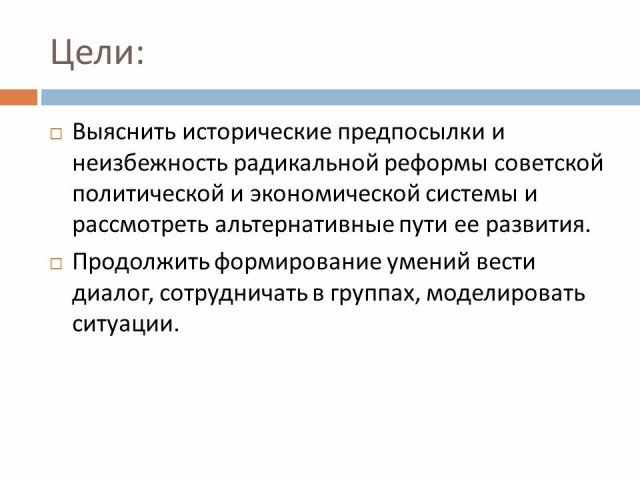
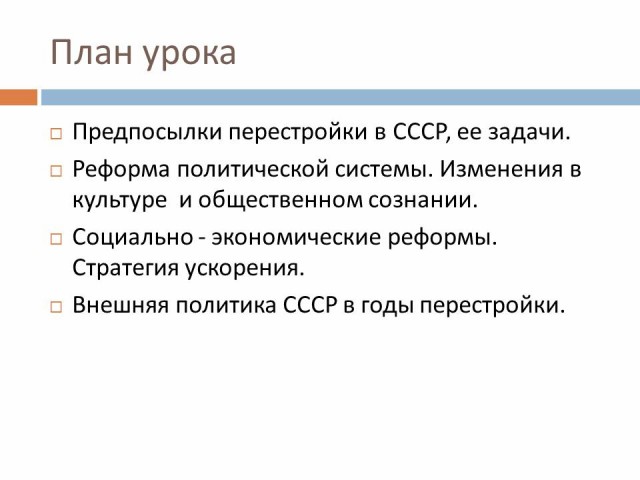
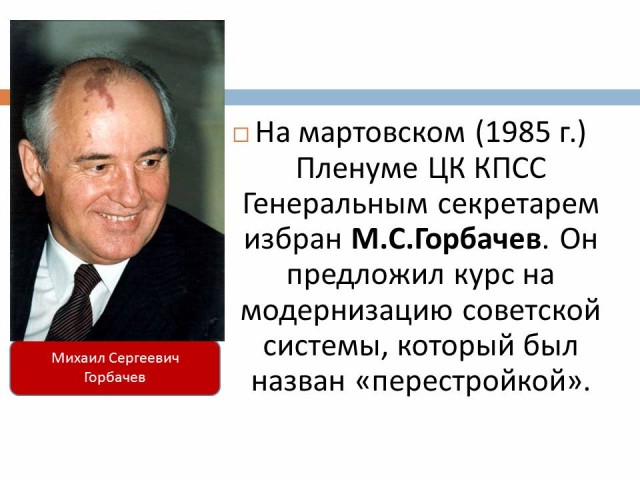
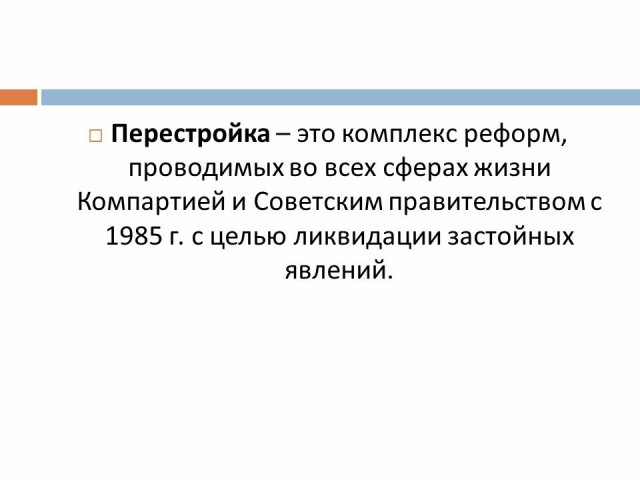
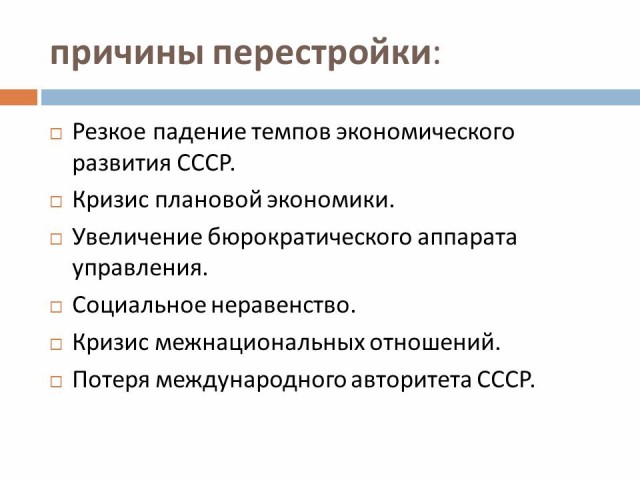
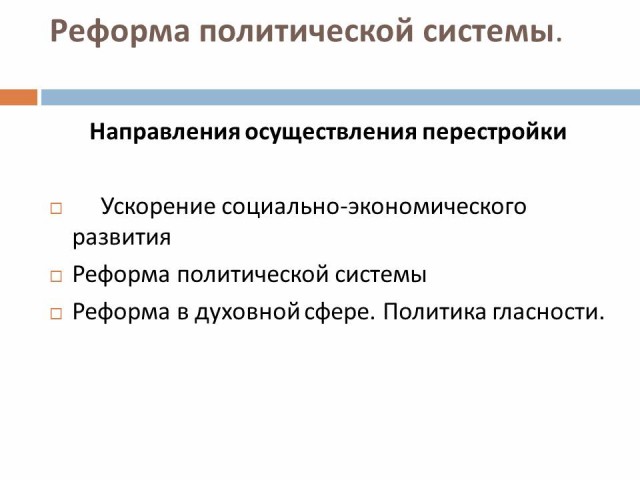


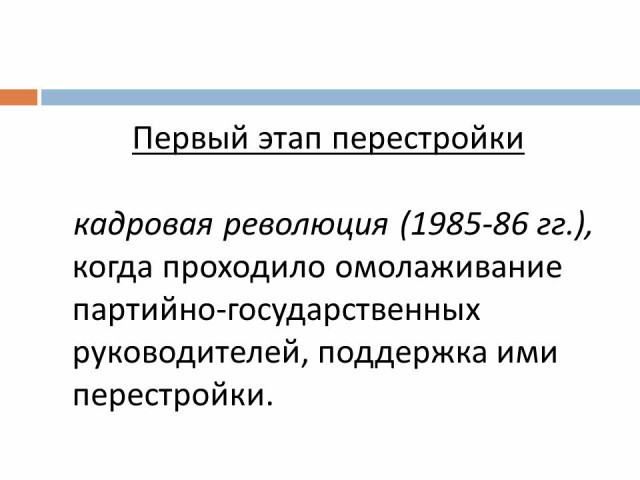
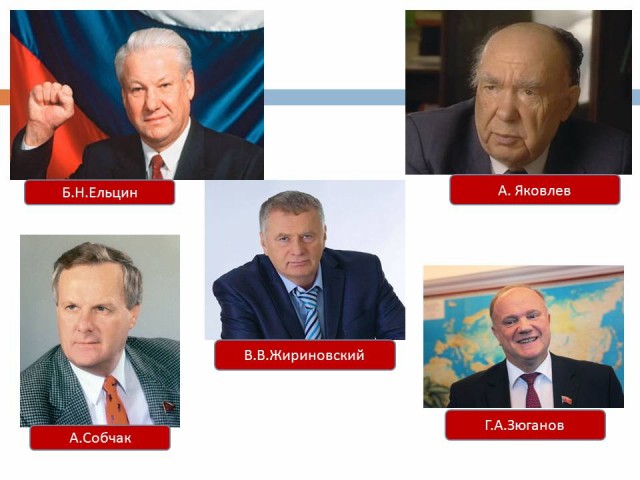


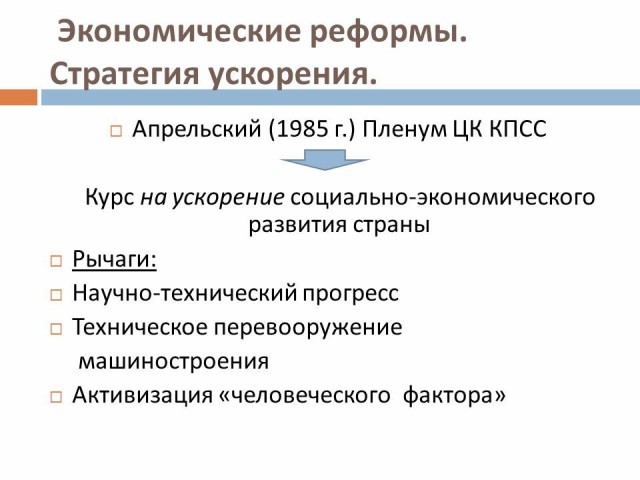
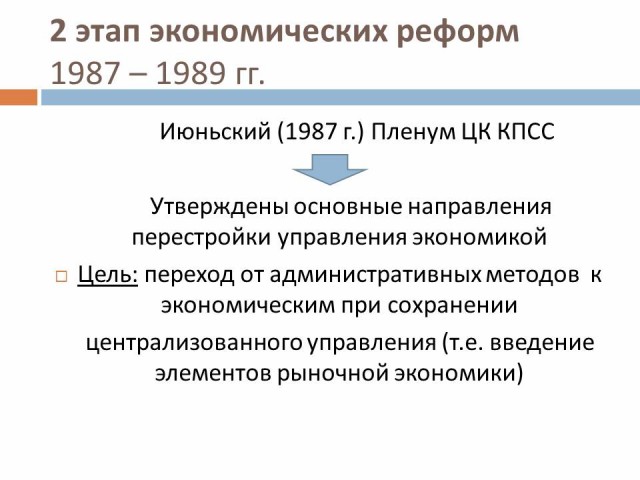

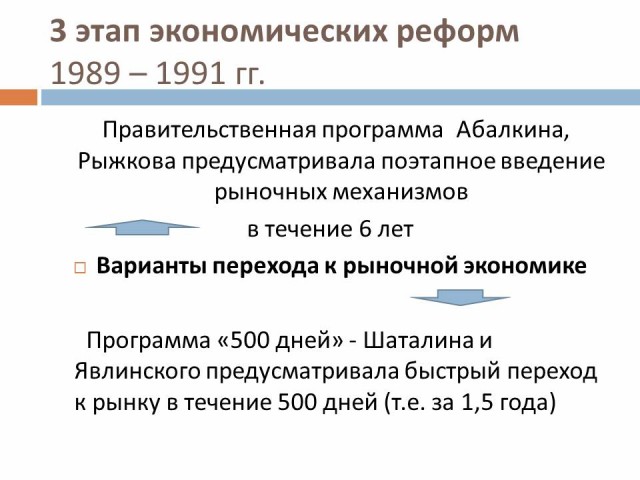
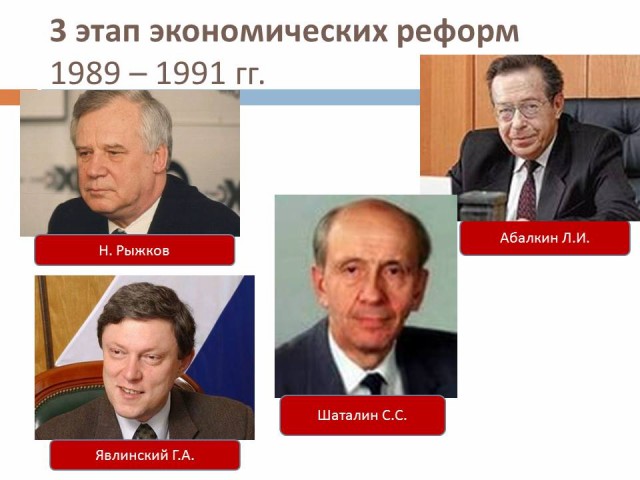


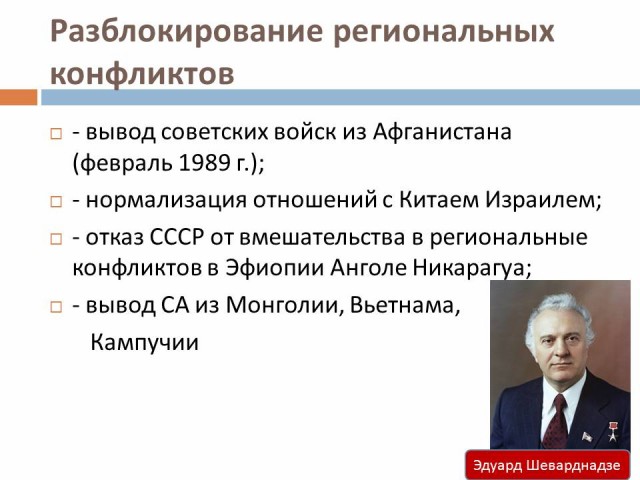

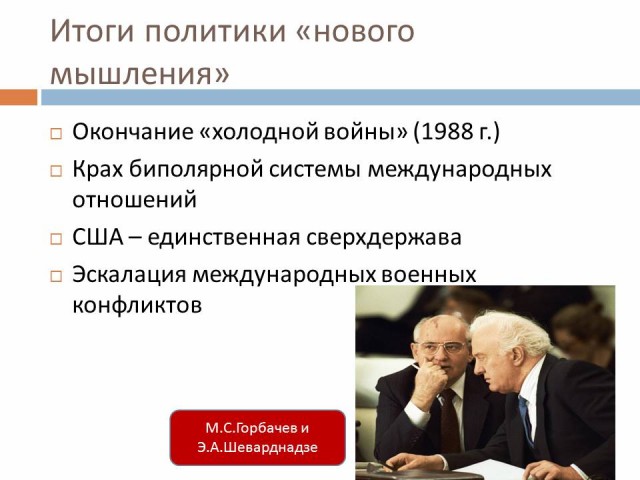
 Back forward
Back forward
Attention! The slide preview is for informational purposes only and may not represent the full extent of the presentation. If you are interested in this work, please download the full version.
Goals:
- Find out the historical background and the inevitability of a radical reform of the Soviet political and economic system and consider alternative ways of its development.
- Continue the formation of skills to conduct a dialogue, cooperate in groups, simulate situations.
Lesson type: a lesson in studying a new topic (the topic is studied in a 2-hour lesson)
During the classes
Organizing time.
Exploring a new topic.
- Prerequisites for perestroika in the USSR, its tasks.
- Reform of the political system. Changes in culture and public consciousness.
- Social - economic reforms. acceleration strategy.
- Foreign policy of the USSR in the years of perestroika.
Topic Dictionary:
Publicity is the availability of information for public review and discussion.
1. Prerequisites for perestroika in the USSR, its tasks.
At the March (1985) Plenum of the Central Committee of the CPSU, MS Gorbachev was elected General Secretary. He proposed a course towards the modernization of the Soviet system, which was called "perestroika".
Perestroika is a set of reforms carried out in all spheres of life by the Communist Party and the Soviet government since 1985 in order to eliminate stagnation.
Task: listening to the story, name causes reforms in all spheres of society.
By the mid 80s. in the socio-economic system of the USSR, “stagnation” gradually turned into a crisis situation. The Soviet economy lost its dynamism. There was a drop in the growth rate in the industry. Crisis phenomena were observed in the sphere of the consumer market and finance (including in connection with the fall in world oil prices).
In 1965-1985 the formation of the main institutions of the Soviet bureaucratic system was completed. There was a degradation of the ruling elite - the nomenklatura, which was mired in corruption and protectionism. Society faced the phenomenon of gerontocracy, when aging sick leaders were in power.
There was also a crisis in the social sphere. In the beginning. In the 1980s, real per capita incomes fell, and life expectancy declined. The remaining egalitarian and scarce system of distribution in the lower part of the social pyramid came into conflict with the protected system of privileges of the nomenklatura.
There were problems in interethnic relations. The Union republics demanded real rights and the ability to independently solve economic and social problems, blaming the Russian population for the crisis,
The ongoing Cold War and the established bipolar system led by the US and the USSR resulted in an exhausting arms race. The stalemate of the Afghan war contributed to the aggravation of the international situation. All this happened against the backdrop of the increasing economic and technological backwardness of the USSR from developed countries.
So, reasons for perestroika:
- A sharp drop in the rate of economic development of the USSR.
- The crisis of the planned economy.
- An increase in the bureaucratic apparatus of management.
- Social inequality.
- The crisis of interethnic relations.
- Loss of the international prestige of the USSR.
Task: based on the reasons, formulate the tasks of restructuring.
Restructuring tasks:
- In the field of economics - to change the economic model, to create a market economy, to eliminate the backlog from the advanced countries.
- In the social sphere, to achieve a high standard of living for the entire population.
- In the field of domestic politics - to change the political regime, to create a democratic, civil society, a constitutional state, to change the concept of relations between the republics within the framework of the Union.
- In the field of foreign policy - to create a new doctrine of state security, to develop new approaches to international relations.
Conclusion: in the early 80's. the crisis of the system matured in the country, all sectors of society were interested in transformations.
2. Reform of the political system
.Directions for the implementation of restructuring
Glasnost is the availability of information for public review and discussion (the term first appeared in February 1986 at the XXVII Congress of the CPSU).
Stages of restructuring:
- April 1985 - January 1987
- Early 1987 - Spring 1989
- Spring 1989 - August 1991
The first stage of restructuring - personnel revolution (1985-86), when the rejuvenation of the composition of party and state leaders took place, their support for perestroika.
On the political arena appeared: Yeltsin, Ryzhkov, Ligachev, Shevardnadze. In connection with the emergence of a multi-party system - Zyuganov (leader of the Communist Party of the Russian Federation), Zhirinovsky (leader of the Liberal Democratic Party), Novodvorskaya (leader of the Democratic Union), Gaidar (leader of Democratic Russia).
Second phase - reform of the political system. Decisions made on:

Democratization of the process of elections to representative bodies of power.
The course towards the creation of a socialist legal state.
Separation of powers. The establishment of a two-tier system of legislative power - the Congress of People's Deputies and the Supreme Soviet of the USSR, elected from the deputies of the congress.
Law on Changing the Electoral System (1988) Direct representation of public organizations in the highest legislative bodies. Of the 2,250 deputies, 750 were elected from the CPSU, Komsomol, trade unions, etc.
The beginning of the formation of a multi-party system.
Elimination of the monopoly right of the CPSU to power by abolishing the 6th article of the Constitution.
Introduction of the post of President of the USSR (March 1990, III Congress of People's Deputies).
In May-June 1989, the First Congress of People's Deputies took place, at which Gorbachev was elected Chairman of the Supreme Council, B.N. Yeltsin became Chairman of the Supreme Council of the RSFSR.
The Third Congress of People's Deputies in March 1990 elected MS Gorbachev President of the USSR.
By the beginning of 1991, Gorbachev's centrist policy increasingly coincided with the position of the conservatives.
| Glasnost Policy Achievements | The cost of publicity |
| Recognition of the crisis of the system; Striving for full awareness of the people; Relaxing censorship Publication of the works of emigrants of the “third wave” (Brodsky, Galich, Solzhenitsyn, Voinovich) Rehabilitation of the repressed 20-50s. Adoption of the Declaration on the illegality of the Stalinist policy of forced resettlement of peoples (November 1989) Filling in the gaps in history. |
Semi-freedom of speech, i.e. permission to say only what was required by the leadership; Defense of Stalinism (N. Andreeva's letter “I can't compromise my principles”, 1988 in defense of Stalin) was published. Glasnost contributed to the clash of ideological, social, national and other currents, which led to the aggravation of interethnic contradictions and the collapse of the USSR. The rise of the yellow press. |
3. Economic reforms. acceleration strategy.
The USSR lagged behind the leading world powers in terms of economic development, the economy plunged into a crisis. Restructuring of the economy was taking place all over the world; the transition to the information society was carried out, in our country the economy experienced stagnation.
Assignment: Independent group work of students with the text of the textbook, highlighting 3 stages of economic reform. Make notes in the form of a diagram.
| 1st stage of reforms
Outcome: acceleration has come to a standstill. |
April (1985) Plenum of the Central Committee of the CPSU The course to accelerate the social-economy. development of the country Levers: Scientific and technical progress Technical re-equipment of mechanical engineering Activation of the “human factor” The introduction of state acceptance, which led to the growth of the administrative apparatus, an increase in material costs; Intensive operation of old equipment led to an increase in accidents (the largest disaster was the accident at the Chernobyl nuclear power plant in April 1986) |
| 2nd stage of reforms 1987 - 1989 Goal: transition from administrative to economic methods while maintaining centralized management (i.e. the introduction of elements of a market economy) |
June (1987) Plenum of the Central Committee of the CPSU The main directions for the restructuring of economic management were approved
Enterprise Law (1987) The beginning of the development of laws in the sphere of private initiative creation of activity cooperatives” Laws 1988
Options for the transition to a market economy |
3rd stage of reforms
Outcome:
- Discussion of programs in the Supreme Council - autumn 1990
- We synthesized both programs and issued a declaration of intent.
- It provided for the transition to the market in the USSR by 1997.
- The refusal of the Union republics to accept it for execution.
Conversation on:
- What does the term "acceleration" mean? What are the acceleration levers? Results?
- What elements of a market economy have been introduced?
- What program for overcoming the crisis did Yavlinsky, Shatalin, Ryzhkov propose?
- How did the collapse of economic reforms affect the fate of the Soviet state?
4. Foreign policy of the USSR during perestroika.
Teacher's word. The change in foreign policy strategy was prepared by the arrival of a new leadership at the Ministry of Foreign Affairs in 1985, headed by Shevardnadze E.A.
Gorbachev M.S. put forward a new philosophical and political concept, called "new political thinking". Its main provisions were:
Rejection of the idea of splitting the world into two opposing systems, i.e. abandonment of the Cold War policy;
Refusal to use force as a means of resolving international problems;
Recognition of the world as integral and indivisible;
The priority of universal human values, the recognition of generally accepted norms of morality.
New political thinking is a set of ideas and approaches that express the interests of people, regardless of their nationality and state affiliation, and ensure the survival of mankind in the nuclear space age.
The main priorities in the foreign policy of the USSR after 1985
- Reducing tensions between East and West through disarmament talks with the US;
- Settlement of regional conflicts;
- Recognition of the existing world order and expansion of economic ties with all countries.
Directions of the foreign policy of the USSR
| Normalization of East-West relations | Unblocking regional conflicts | Establishment of economic and political contacts |
| - meetings of US-USSR leaders: 1985 - Geneva 1986 - Reykjavik 1987 - Washington 1988 - Moscow; Treaty on the destruction of intermediate and short-range missiles; Treaty on the Limitation of Strategic Offensive Arms (OSNV-1) -1991. |
- withdrawal of Soviet troops from Afghanistan (February Normalization of relations with China Israel; Refusal of the USSR to intervene in regional conflicts in Ethiopia, Angola, Nicaragua; Withdrawal of the SA from Mongolia, Vietnam, Kampuchea. |
- “Velvet revolutions” in the countries of socialism, non-intervention of the USSR; Dissolution of the CMEA, ATS |
RESULTS
- End of the Cold War (1988)
- The collapse of the bipolar system of international relations
- USA is the only superpower
- Escalation of international military conflicts
Findings:
- During the period of perestroika, the Soviet political system was finally destroyed.
- On the wave of democratization, political pluralism and a multi-party system were formed.
- The socio-economic system could not exist outside the administrative-command form, so the half-hearted reforms in the field of the economy failed.
- The Cold War ended, but the international positions of the USSR weakened.
- Perestroika ended with the collapse of the USSR and the collapse of the communist system.
Reflection:
Define the terms:
- perestroika
- "Personnel revolution"
- Acceleration strategy
- Publicity policy
- Regional conflicts
- Velvet revolutions
List of used literature
- Artemov V.V., Lyubchenkov Yu.N. History for professions and specialties of technical, natural science, socio-economic profiles: a textbook for the beginning. and avg. prof. education: in 2 Ch., M., 2011, - Ch 2, paragraph 97.
- Araslanova O.V., Pozdeev A.V. Lesson developments on the history of Russia (XX - beginning of the XXI century): Grade 9. - M., 2007, - 320 p.



